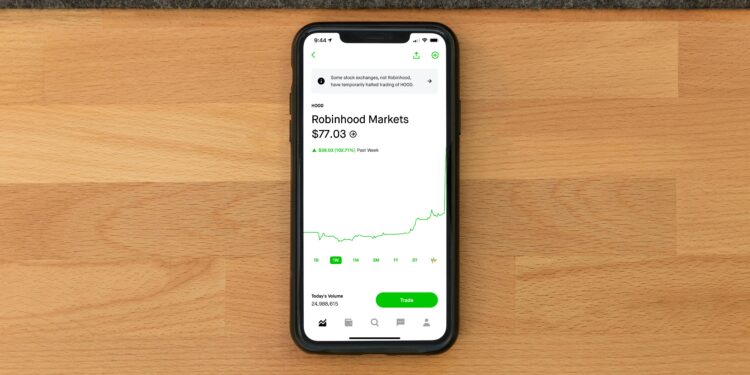Upgraded to Overweight as New Products and Generational Shifts Poise Robinhood for Long-Term Growth
Robinhood Markets (HOOD), the pioneering mobile-first brokerage platform, has recently seen its stock price decline by 27% since reaching a 52-week high of $24.36 on July 16. This significant pullback, however, presents a compelling entry point for investors as the company is positioned for both near-term recovery and long-term growth. With its innovative platform, strategic product rollouts, and favorable demographic trends, Robinhood is set to capitalize on a variety of market opportunities that could propel its stock upward.
Near-Term Catalysts: Product Expansion and Trading Activity
One of the key drivers behind Robinhood’s potential resurgence is its upcoming launch of a web-based trading platform. While Robinhood has dominated the mobile trading space, accounting for a substantial share of the global retail market, it has largely been absent from the desktop trading arena. This gap has limited its reach, as nearly half of all U.S. retail trading occurs on web-based platforms, which provide traders with more screen space to execute complex strategies and utilize advanced tools.
The introduction of a robust web-based platform will enable Robinhood to compete more effectively with established brokerage firms that cater to more experienced traders. This move is also expected to enhance retention rates among Robinhood’s maturing user base, many of whom are millennials who have grown accustomed to mobile trading but may now seek the enhanced capabilities offered by a desktop interface.
Another significant near-term catalyst is the expected increase in trading activity due to anticipated Federal Reserve rate cuts. While lower interest rates typically result in a decline in net interest income (NII), which has been a substantial component of Robinhood’s revenue, the potential surge in trading activity and margin loan growth is likely to offset this impact. Robinhood’s management has indicated that even a modest 3% increase in trading revenue could neutralize the negative effects of a single rate cut, making the company resilient to monetary policy shifts.
Moreover, the upcoming rollout of index options and futures trading on Robinhood’s platform is poised to attract a new segment of traders who have, until now, been excluded from these markets. The explosion of “zero days to expiration” (0DTE) trading in recent years has highlighted the demand for index options, and Robinhood’s entry into this space could significantly boost trading volumes and profitability.
Long-Term Growth Prospects: Generational Wealth Transfer and Global Expansion
Beyond the immediate opportunities, Robinhood is also well-positioned to benefit from several long-term trends. One of the most promising is the generational wealth transfer that is expected to occur over the next two decades, as baby boomers pass down trillions of dollars in assets to their children. Robinhood’s customer base is predominantly composed of millennials and younger generations, who are more inclined toward self-directed investing. This demographic shift could drive substantial growth in assets under custody (AUC) for Robinhood.
Currently, Robinhood manages approximately $140 billion in retail assets, which is less than 0.3% of the estimated $65 trillion in total U.S. retail assets. As this wealth transfer progresses, Robinhood’s share of the market could expand significantly, providing a strong tailwind for revenue growth. Even if the trading revenue per dollar of AUC were to decline as Robinhood adds more passive accounts, the sheer volume of new assets could still generate meaningful revenue increases.
Robinhood’s foray into international markets also presents a substantial growth opportunity. While the company is still in the early stages of its global expansion, the potential to tap into new markets with its user-friendly platform could drive significant user growth and revenue diversification. As more countries embrace digital and mobile trading, Robinhood’s model is likely to resonate with a global audience, further solidifying its position as a leader in retail investing.
Innovative Product Offerings: Boosting Revenue Streams
Robinhood has consistently focused on enhancing its product offerings to capture a larger share of its customers’ wallets. The company’s Robinhood Gold subscription service, which provides users with premium features for a monthly fee, has seen impressive growth, with a 60% increase in subscribers in the second quarter of 2024 alone. The planned introduction of new products, such as a Gold credit card, could further boost subscription revenue and deepen customer engagement.
The potential for Robinhood to increase the price of its Gold subscription plan, currently set at $5 per month, also presents an opportunity to drive additional revenue. With nearly 2 million subscribers, even a modest price increase could generate significant incremental income, providing a buffer against any downturns in trading revenue or interest income.
Conclusion: A Strategic Bet on Innovation and Demographics
In conclusion, Robinhood’s recent stock pullback offers a strategic buying opportunity for investors who believe in the company’s ability to innovate and adapt to changing market conditions. With the launch of a new web-based trading platform, the introduction of index options and futures, and the long-term tailwinds from generational wealth transfer and international expansion, Robinhood is poised for growth. While near-term challenges such as rate cuts may pose risks, the company’s diversified revenue streams and focus on product development position it well for sustained success in the competitive brokerage industry.
You might like this article:Starbucks and Elliott Management in Settlement Talks Amid Investor Pressure











